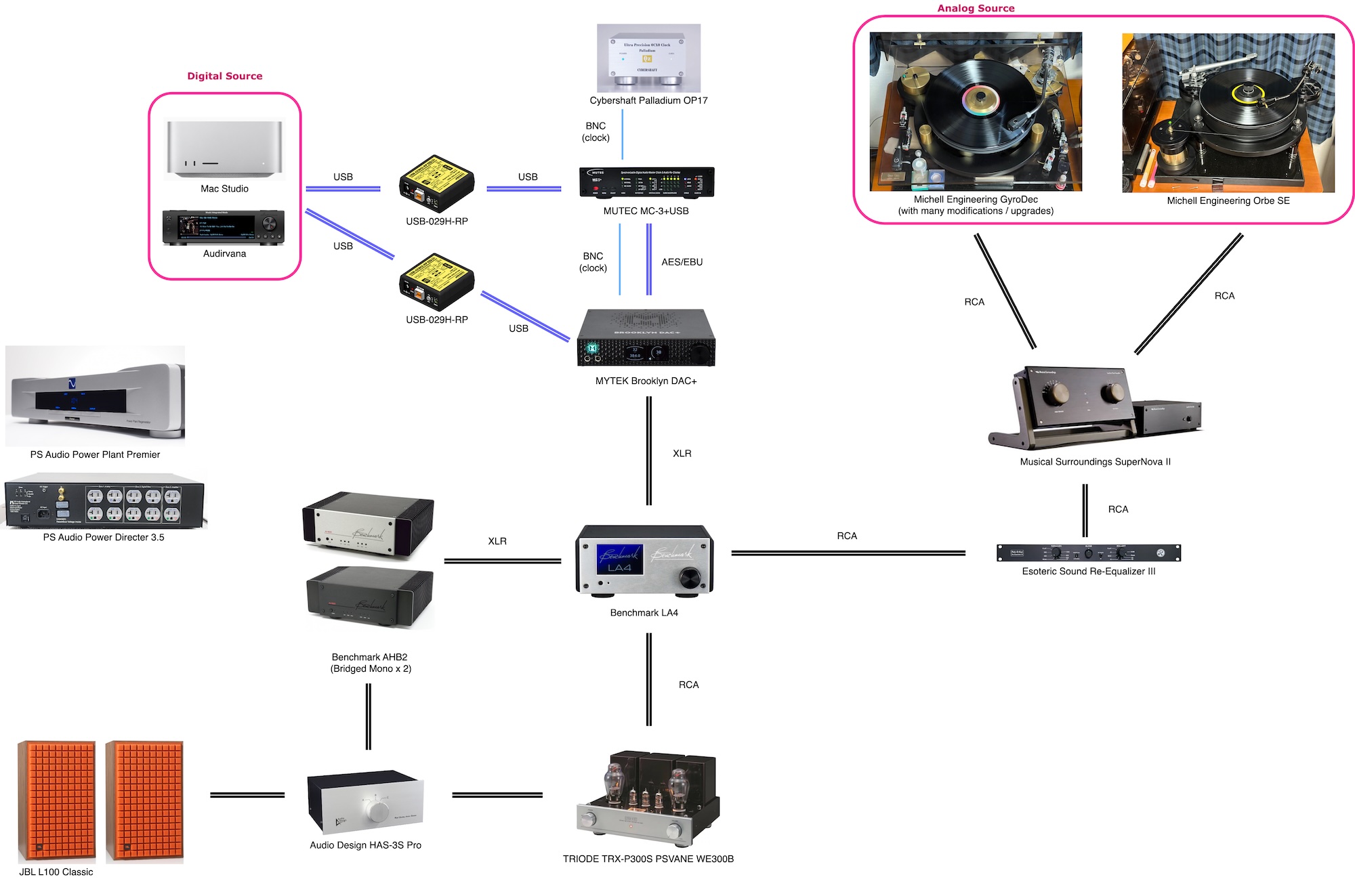Contents / 目次
Introduction / 余談からスタート
我が家のオーディオ環境では、2004年に TEAC VRDS-25X の中古を導入するまでは、カーオーディオと兼用していたポータブルCDプレーヤや、タダで譲り受けた LD/CD プレーヤなどで、CD を聴いていました(笑)
In my home audio environment, until I installed a used TEAC VRDS-25X in 2004, I listened to CDs with a portable CD player (which was also used with my car audio system), or with a LD/CD player I got for free 🙂
当時はアナログ再生がメインだったからですが、かといって「アナログマンセー」だったわけではありませんし(笑)、今でもディジタル再生も同じくらい好んでいます。
This was because analog was my main source for listening at the time, but that does not mean that I was an “analog supremacist”, and I still prefer digital playback as much as analog playback.
2012年初頭、(のちに Musical Surroundings MYDAC II として製品化された)DAC のプロトタイプ基板 を開発者の Michael Yee さんにいただいたことをきっかけにして、CD を直接再生することはなくなり、CD をリッピングしたのち PC から DAC 経由で再生するようになりました。ここから我が家での本格的なディジタル再生が始まりました。
In early 2012, Mr. Michael Yee, the developer of the audio components, kindly gave me a prototype DAC board (which later commercialized as Musical Surroundings MYDAC II). After that, I stopped playing CDs directly, and my primary digital audio playback method became “playing digital files (that were ripped from CDs) from PCs via DACs”. This was the beginning of full-fledged digital playback in my home.
以前から CD を購入するたびに、XLD (X Lossless Decoder) や Exact Audio Copy を使い、ALAC (Apple Lossless) 形式のディジタルファイルとして SSD や NAS に保存しており、現在はこれを Audirvāna Origin + Music app (旧名 iTunes) から DAC に流し込んで再生しています。
Even since before 2012, I have always used such software as Exact Audio Copy and XLD (X Lossless Decoder) to rip the CDs as digital files in ALAC (Apple Lossless) format on my SSD or NAS. Recentely I always play these audio files using the combination of Audirvāna Origin and Music app (was: iTunes) via the DAC.
いまだに Audirvāna Origin を「Music Integrated Mode (legacy)」モードで使っている(Audirvana はあくまでバックエンドで、iTunes/Music をフロントエンドとして使用)のは、取り込み年月日、再生回数、最終再生年月日などのデータを、iTunes/Music から他のアプリに持って行けないからです(笑)
I still use Audirvāna Origin in “Music Integrate Mode (legacy)” mode (i.e. Audirvana for backend, iTunes/Music for frontend), simply because there is no way to bring statistical data (such as imported date, play count, last played date etc.) to other apps.

上記余談はさておき、CD 上の音源を PC 上にもってくることで、ディジタルデータとしての客観的な数値やパラメータを目にすることが容易になります。
Returning to the main subject — by bringing the sound source on the CD to the PC, it becomes much easier to see the objective values and parameters as digital data.
今回のお題、「CD におけるモノーラル音源」も、そんな中で気づいたものでした。
The subject here, “monaural sound sources on CDs” was also something I noticed in this context.
2012年7月下旬、あるモノーラル音源のCDをリッピングしている時、トラックによってファイルサイズがかなり違うことが気になったのです。残念ながら、この時の CD がどれだったのか、いまだに思い出せずにいるのですが。
It was in late July 2012, while I was ripping a certain monaural CD (which I still can’t remember it was, though), I noticed that the file size varied considerably from track to track.
以下、本稿を通じて、「左右チャンネルがバイナリ一致したモノーラルCD」と「そうではないモノーラルCD」との間での優劣について書いているわけではなく、両者の差が生じる要因に純粋に興味があることにご留意ください。
Throughout this article, I am NOT going to discuss “is the true 2-track mono CD (with binary identical channels) better audio-wise than the CD which is not?”, but am just interested in what made this difference.
FLAC (and ALAC): lossless data compression of digital music
そもそも、オーディオCD(CD-DA)の規格では、音声データは「サンプリング周波数 44,100Hz の符号付き 16ビット LPCM、2チャンネル、左チャンネルが先に格納されるインターリーブ、リトルエンディアン」で記録されています。
To begin with, in the Audio CD (CD-DA) Standard, audio data is recorded in “signed 16-bit LPCM, with a sampling frequency of 44,100Hz, two channels, interleaved with the left channel stored first, little-endian”.
\(44,100 (sample/second/channel) \times 16 (bit/sample) \times 2 (channel) \\ = 1,411,200 (bit/second) = 1,411.2 kbit/s\)
すなわち、オーディオCDは2チャンネルが大前提であり、1チャンネルのみを格納したオーディオCDというのは規格上存在しないことになります。よって、左右2チャンネルに全く同一のデータが記録されている場合、いわゆるモノーラルでの記録と同等である、といえます。
In other words, the basic premise of an audio CD is to have two audio channels: an audio CD that contains only one audio channel does not exist in the standard. Therefore, if the data of a particular CD is exactly the same in both channels, it is equivalent to a monaural recording.
そして、FLAC (Free Lossless Audio Codec) や ALAC (Apple Lossless Audio Codec) といった CODEC(符号化/復号化アルゴリズム)を使った音源データは、いわゆる「ロスレス」の可逆圧縮音源です。
Next, sound data using CODECs (coding/decoding algorithms) such as FLAC (Free Lossless Audio Codec) and ALAC (Apple Lossless Audio Codec) are so-called “lossless” compressed audio sources.
符号化アルゴリズムや圧縮アルゴリズムの仕組みを学んだことのある方は容易に想像できると思いますが、2チャンネルステレオの音源ファイル1つがあるとして、左右チャンネルの音源データが全く同一である(=モノーラル音源と等価とみなせる)場合、1ファイルとしての圧縮率はあがり、結果として .flac ファイルや .m4a ファイルのサイズは小さくなるはずです。
As those who have studied the mechanisms of encoding and compression algorithms can easily imagine, if there is a single two-channel stereo sound file and the sound data for the left/right channels are identical (i.e. can be considered equivalent to a monaural sound source), the compression ratio for a single file should increase. Also, as a result, the size of the .flac file or .m4a file should be smaller.
例として、「The Capitol Albums Vol. 1」(Capitol CDP 7243 8 66878 2 1, 2004) の CD 1「Meet The Beatles!」に収録された、「It Won’t Be Long」のステレオバージョン(Track 4)とモノーラルバージョン(Track 16)をみてみましょう。
Here’s a typical example. Let’s take a look at the stereo version (track 4) and monaural version (track 16) of “It Won’t Be Long” on “Meet The Beatles!”, CD 1 of the “The Capitol Albums Vol. 1” (Capitol CDP 7243 8 66878 2 1, 2004).
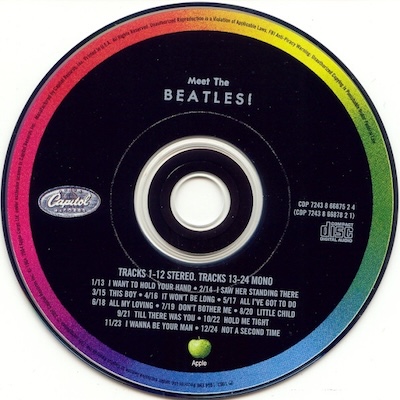
双方とも、AIFF (Audio Interexchange File Format) や WAV (Waveform Audio Format) など、非圧縮(ビットレート 1,411kbp/s)の形式では、ファイルサイズはほぼ同一です。
Both of the ripped files have nearly identical file sizes in uncompressed (1,411kbp/s) formats such as AIFF (Audio Interexchange File Format) and WAV (Waveform Audio Format).
これを ALAC や FLAC といった可逆圧縮形式のファイルにすると、モノーラルバージョンは左右チャンネルが同一であるため、ステレオバージョンに比べてファイルサイズが小さくなります。
When these files are convered to files in lossless compression formats such as ALAC or FLAC, the file size of the monaural version is smaller than the that of the stereo version, because the monaural version has the same digital data both for the left and right channels.
| Track 4 (Stereo Version) | Track 16 (Mono Version) | |
|---|---|---|
| Track Time | 02:13.693 | 02:13.747 |
| Filesize (uncompressed, AIFF) |
23.7MB (23,733,024 bytes) | 23.7MB (23,742,450 bytes) |
| Filesize (compressed, ALAC) |
18.2MB (18,205,245 bytes) | 11.6MB (11,557,622 bytes) |
| Compression Rate | 76.7% | 48.7% |
| ALAC bitrate | 1,078kbps | 681kbps |
このように、モノーラル音源と謳われた CD というのは、オーディオCD上に記録された左右チャンネルのデータが同一であろうと考えられます、というか、私はそう思っていました。
Thus, a CD that is claimed to be a monaural source is considered to have the same left and right channel data recorded on the audio CD — or more precisely, I had thought as such.
ところが、世の中に流通する全てのモノーラル音源とされる CD の中には、可逆圧縮形式で取り込んでも、ファイルサイズが思ったほど小さくならないものがあります。
However, I found some of the “monaural” CD in circulation are not the case: even when ripped then convered into lossless compression format, the file size is not as small as expected.
また、再生時にピークメータをみていると、モノーラル音源とされているのに、左右のレベルがずれていたりするのを見かけることもあります。
Also, if you look at the peak meter during digital playback, you may see that the left and right levels are off, even though the source is considered a monaural source.
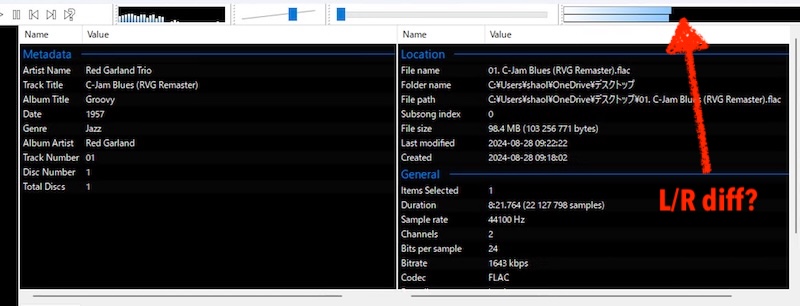
“Groovy / Red Garland” (Prestige PRCD-30652, RVG Remasters, 2008) と同等のマスタリングの 24/44.1 ハイレゾ音源 の Track 1 を foobar2000 で再生した際のレベルメータ、左右チャンネルが揃っていない
つまり、「もしかして、『モノーラル音源とされているが、実は左右チャンネルのデータに差分がある(=完璧なモノーラル音源と等価とはみなせない)音源』って、思った以上に多くあるのではないだろうか?」、そのように疑問に思ったのでした。
In other words, this was what I was / had been wondering. “Could it be that there are more sound sources that are considered to be monaural but actually have differences in the left/right channels (i.e. cannot be regarded as equivalent to a perfect monaural sound source) than I/we thought?”
その時はあまり深追いしなかったのですが、昨年ふとそのことを 思い出し、手元のいろんな音源をたまに調べてみたりしていました。
I didn’t follow it too closely at the time, but last year I suddenly remembered it out of nowhere, and occasionally checked various sound sources from my collection.
How To Compare Two Channels of “Mono” CD Audio Data
モノーラル音源とされるCDの 左右チャンネルの差分を調べる方法 はいろいろありますが、ここでは誰でも簡単に行えるものとして、オープンソースかつマルチプラットフォームの音声編集ソフト Audacity を使う方法を紹介します。
There are many ways known to find out the difference between the left and right channels of a “monaural” CD, but here I will introduce a method that anyone can easily reproduce using Audacity, an open-source, multi-platform audio editing software.
ここではサンプルとして、「Complete Works Of Edgard Varèse, Volume 1」(Él Records ACME336BOX, 2018) の CD 1 冒頭の「Intégrales (1923-25)」を使用します。1950年録音ですから、もちろんモノーラル音源です。
As a sample here, I use “Intégrales (1923-25)” from the first track of CD 1 of “Complete Works Of Edgard Varèse, Volume 1” (Él Records ACME336BOX, 2018). As was recorded in 1950, it is of course a monaural recording.
まず、CDからリッピングされた音声ファイルを Audacity で開くと、2チャンネル(ステレオ)の1トラックとなっているはずです。これを「Split Stereo to Mono」で、1チャンネル(モノーラル)の2トラックに変換します。
First, when you open an audio file ripped from the CD in Audacity, it should be a single 2-channel (stereo) track. Use “Sprint Stereo to Mono” to convert it to two tracks of one channel (monaural).

続いて、片方のトラック(=元々ステレオの片チャンネルだったもの)の全体を選択し、「Effect」メニューから「Invert(位相反転)」を適用します。
Then select the entirety of one track (i.e. what was original one channel of stereo) and apply “Invert” from the “Effect” menu.
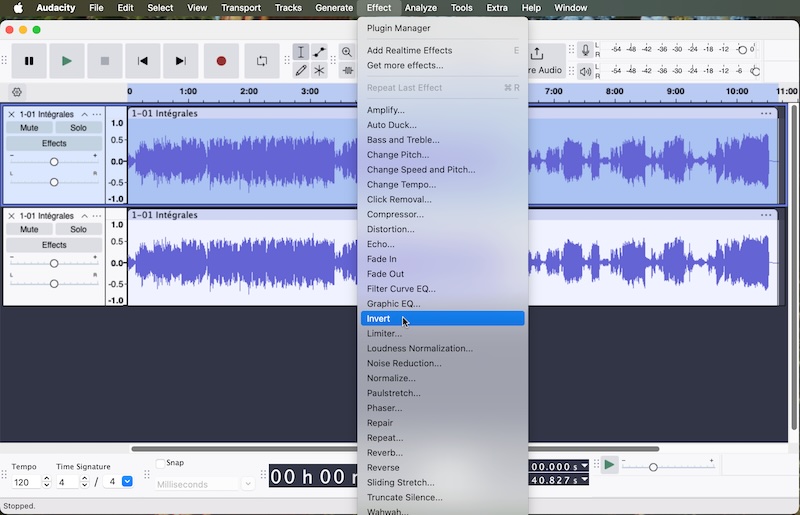
最後に、両トラック全体を選択した状態で、「Tracks」メニューから「Mix and Render to New Track」を実行します。
Finally, with both tracks selected in their entirety, execute “Mix and Render to New Track” from the “Tracks” menu.
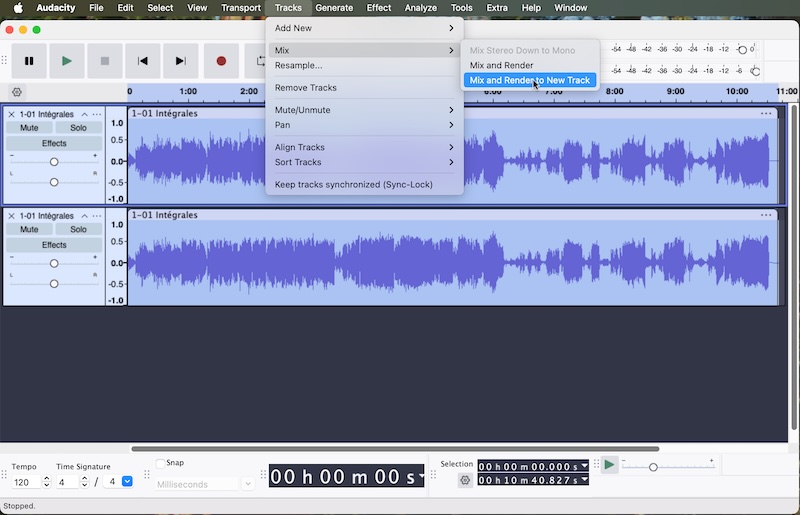
すると、位相反転された片チャンネルがもう片チャンネルと合成された結果が、3トラック目に生成されます。差分がなければ、一直線(無音)になるはずです。
The result of one phase-inverted channel being combined with the other channel is then generated on the third track. If there is no difference between the left/right channels, the result should be a straight line (silence).

3トラック目の表示形式を「Waveform」から「Spectrogram」に変えても、差分を視覚的に確認しやすいでしょう。差分がなければ、スペクトログラム表示は真っ黒になるはずです。
Changing the display format from “Waveform” to “Spectrogram” for the third track will also make it easier to visually confirm differences. If there is no difference between the left/right channels, the spectrogram display should be completely black.

つまり、この生成された3トラック目が無音であれば、元の左右チャンネルに収録されていた音声データは全く同一であることを意味します。すなわち、その場合はモノーラル音源がそのまま収録された2チャンネルオーディオ音源とみなしてよいことになります。
In other words, if this generated third track is silent, it means that the audio data recorded in the original left/right channels is exactly the same. In that case, the monaural sound source can be regarded as a 2-channel audio source recorded as it is.
ところが、先ほど上の foobar2000 のスクショで出てきた「Groovy / Red Garland」(RVG Remasters, 2008) のケースでは、波形でも、スペクトログラムでも、左右チャンネルの差分がかなり存在していることが視覚的に確認できます。
However, in the case of “Groovy / Red Garland” (RVG Remasters, 2008), which already appeared in the foobar2000 screenshot above, it can be visually confirmed in both the waveform and spectrogram that there is a significant difference between the left/right channels.
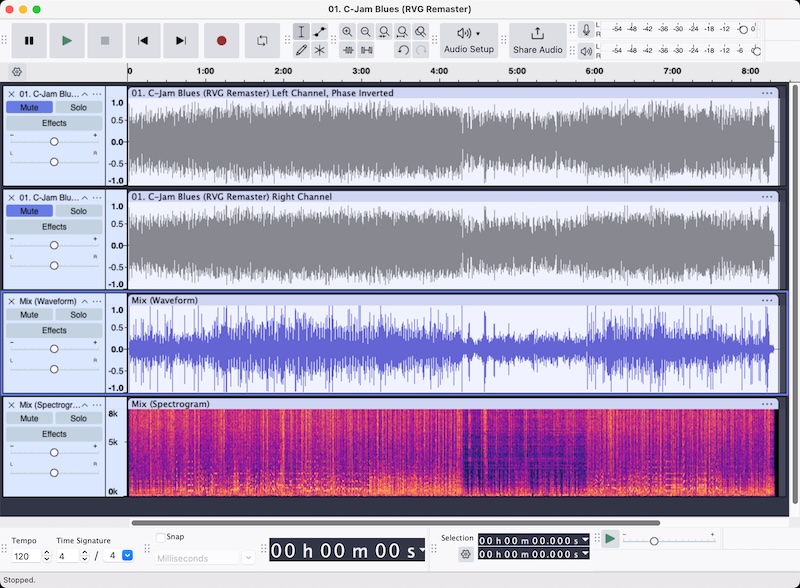
“Groovy / Red Garland” (Prestige PRCD-30652, RVG Remasters, 2008) と同等のマスタリングの 24/44.1 ハイレゾ音源 の Track 1 で、左右チャンネルの差分(下の2トラック)を生成すると、差分がかなり大きいことが確認できる。
Some Examples (wee bit though) / 手元のいくつかの例
世の中には、モノーラルとされる音源やCDが過去〜現在に大量にリリースされていますので、それらの全てを調べることは不可能です(笑)
In the past and present, vast numbers of “monaural” CDs has been released in the world, and it is virtually impossible to examine all of them 🙂
ですが、ここでは、「きっとこのCDは左右差分なしだろう」「これは絶対差分ありそう」と、なんとなくあたりをつけて、手元の音源からいくつかサンプルとしてみていくことにします。
Here, however, I’m going to take a look at a few examples from my collection, with some guesses as to whether “this CD will probably have binary identical 2-track mono data” or “this CD will definitely have a difference between two channels”.
Mexican R’n’B / The Stairs (1992)
1991〜2年という短期間にインパクトの強い足跡を残した The Stairs。
The Stairs left a strong impactful footprint in a short period of time, from 1991 to 1992.
唯一のアルバム「Mexian R’n’B」(Go! Discs / London 422 828 315-2) および全シングルリリースは、全曲モノーラルでの収録で、当時話題となりました。
Their only album, “Mexican R’n’B” (Go! Discs / London 422 828 315-2) and all single releases were recorded engirely in monaural, and were much talked about at the time.
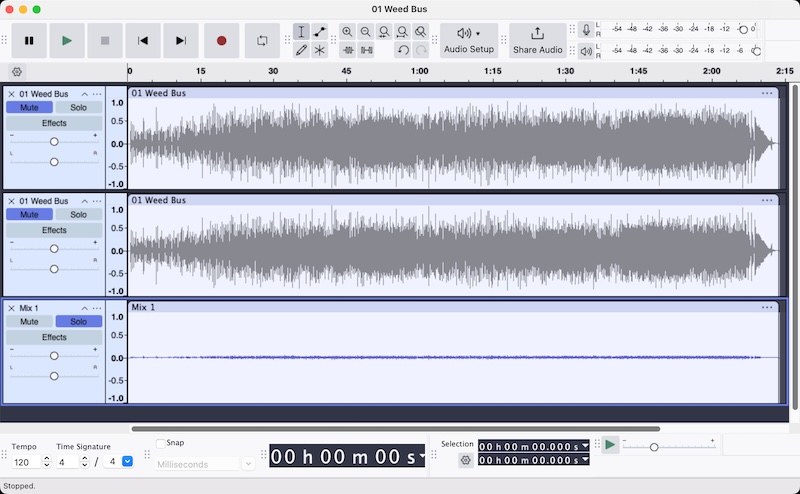
Weed Bus / The Stairs
from “Mexian R’n’B” (Go! Discs / London 828 315-2, 1992)
思ったよりは、左右チャンネルの差分が存在し、完璧なトゥルーモノではないことが確認できます。そして、なぜこうなっているのか、は、おおよそ想像がつきますよね(後述)。
You can see that the difference between the left and right channels is more present than you might expect — it is not a perfect true mono. And you can roughly guess why this is happening (will be discussed later).
Little Saint Nick / The Beach Boys (1963)
1963年11月に Capitol 5096 としてシングルリリースされ、翌年には「The Beach Boys’ Christmas Album」(Capitol ST-2164 / T-2164) にも収録された、老若男女を問わず年末に耳にする「Little Saint Nick」。
“Little Saint Nick” has been enjoyed by young and old alike at the end of each year. It was initially released as a 45 rpm single as Capitol 5096, and later included on “The Beach Boys’ Christmas Album” (Capitol ST-2164 / T-2164).
アルバムには、鈴やセレステ、グロッケンシュピールを除いたバージョンが収録されましたが、オリジナルのモノーラルシングルバージョンは、リイシュー CD のボーナストラックとして収録されてきました。
The version without the sleigh bells, celeste, and glockenspiel was included on the LP album, but the original monaural single version has been included as a bonus track on the CD reissues.
まず、1989年11月に日本でリリースされた 東芝EMI TOCP-5945 の冒頭に収録されたシングルバージョンです。左右チャンネルが完全一致し、完璧にモノーラルとみなせる収録となっています。
First example is the mono single version, from the track 1 of Toshiba EMI TOCP-5945, Japanese release in November 1989. The left/right channels are perfectly matched, thus the particular track can be said as “perfectly monaural”.
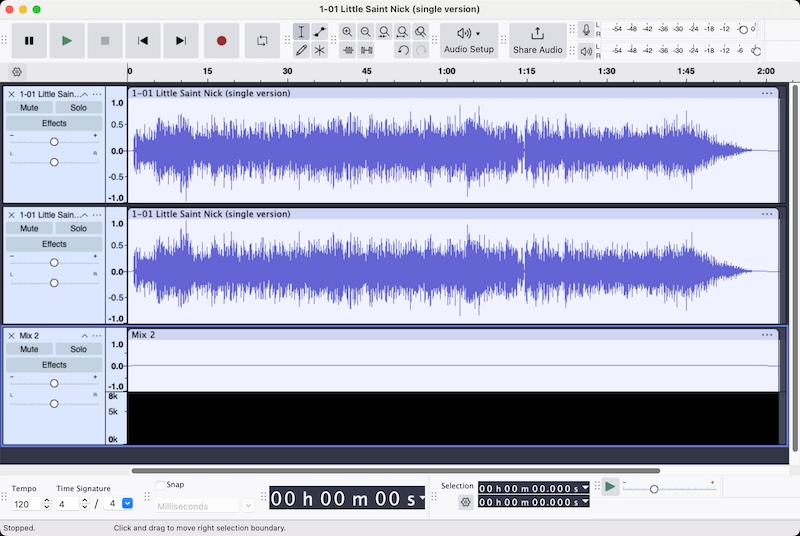
Little Saint Nick (single version) / The Beach Boys
from “The Beach Boys’ Christmas Album” (Toshiba EMI TOCP-5945, 1989)
続いて、1991年に米国でリリースされた Capitol CDP 7 95084 2 に収録されたシングルバージョンです。こちらは、左右チャンネルの差分は比較的多くみられます。
Next example is from the track 13 of Capitol CDP 7 95084 2, U.S. release in 1991. Here, there are relatively more differences visible between the left/right channels.
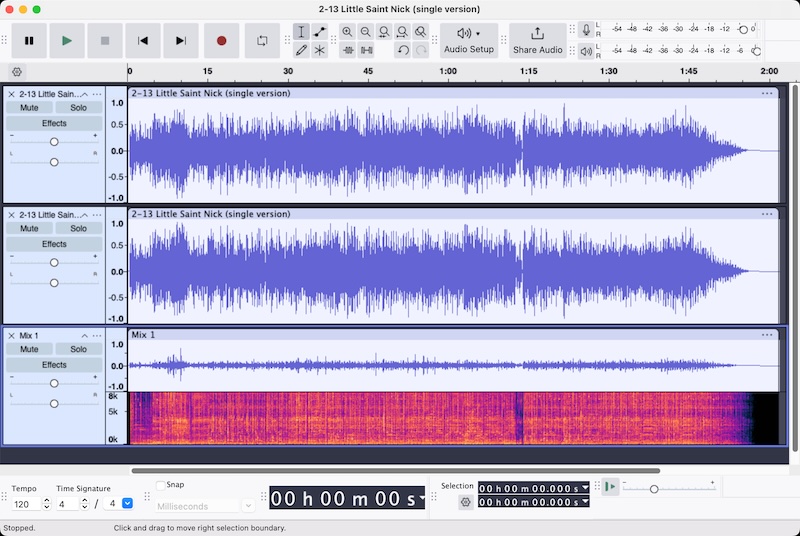
Little Saint Nick (single version) / The Beach Boys
from “The Beach Boys’ Christmas Album” (Capitol CDP 7 95084 2, 1991)
両者でなぜこんな差が起こったのか、これもなんとなく想像ができますね(後述)。
Again, you can roughly guess why this is happening (will be discussed later).
That’ll Be The Day / Buddy Holly (1957)
CD 時代に入って数年後の1985年、ついに Buddy Holly の音源が1stジェネレーションマスターテープから復刻、アルバム「From The Original Master Tapes」として LP / CD 同時発売され、当時は話題になったそうです。マスタリングエンジニアは Steve Hoffman 氏でした。
In 1985, several years after entering the CD era, Buddy Holly‘s memorable recordings were finally reissued from the first-generation master tapes and released simultaneously on LP and CD as the album “From The Original Master Tapes”, which was a hot topic at the time. The mastering engineer was Mr. Steve Hoffman.
このうち、冒頭の「That’ll Be The Day」は、1957年2月25日 Norman Petty Recording Studio 録音のモノーラルですが、1985年版 CD (MCA MCAD-5540, 1985) を調べてみると、やはり左右チャンネルの差分が検出されます。これも理由はなんとなく想像がつきますね(後述)。
Of these, the opening track, “That’ll Be The Day”, is monaural, recorded February 25, 1957 at Norman Petty Recording Studio, Clovis, New Mexico. The examination of the 1985 CD (MCA MCAD-5540, 1985) still detects a difference between the left/right channels. Again, you can roughly guess why it is happening (will be discussed later).
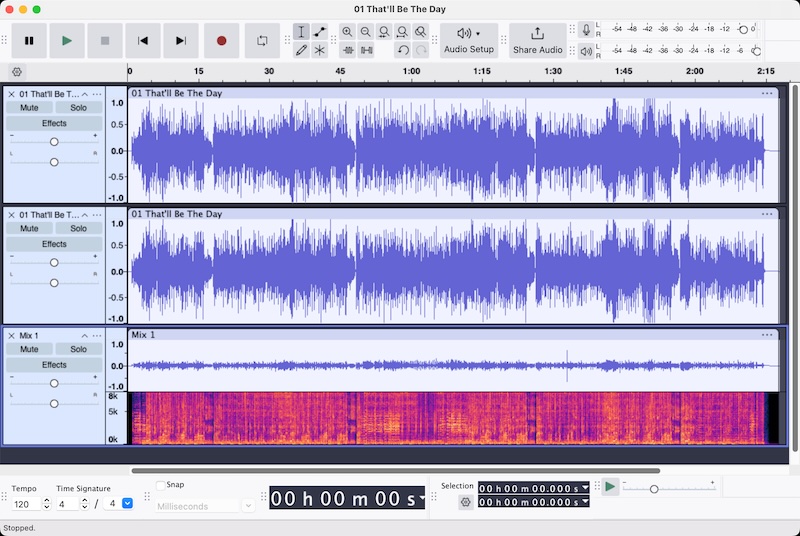
That’ll Be The Day / The Crickets (Buddy Holly)
from “From The Original Master Tapes” (MCA MCAD-5540, 1985)
一方、Erick Labson リマスターのアルバム「The “Chirping” Crickets」リイシュー CD (Decca / Geffen / Chronicles B0001686-02, 2004) と同一マスターと考えられる日本盤 CD (Decca / Geffen / Universal Music K.K. UICY-6744, 2007) を調べてみると、左右チャンネルの差分はゼロでした。
On the other hand, an examination of the Japanese CD (Decca / Geffen / Universal Music K.K. UICY-6744, 2007), which is considered to be using the same master as the CD reissue of “The ‘Chirping’ Crickets” remastered by Erick Labson (Decca / Geffen / Chronicles B0001686-02, 2004) shows zero difference between the left/right channels.
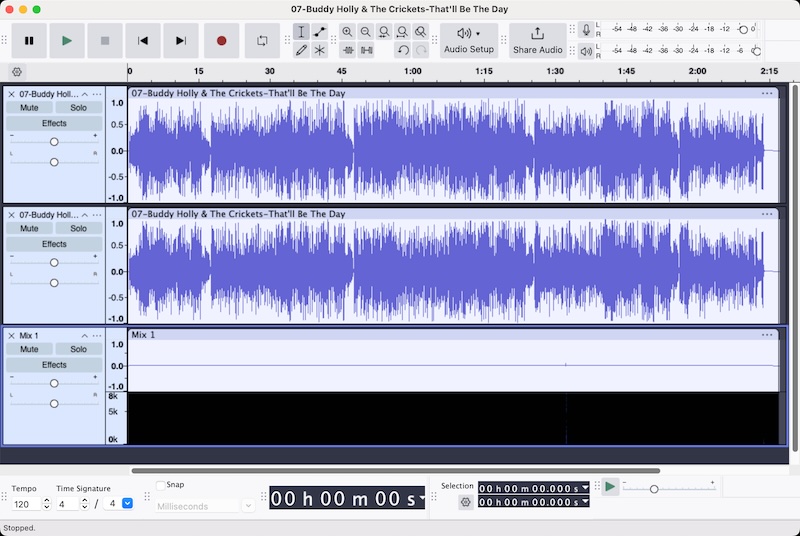
That’ll Be The Day / The Crickets (Buddy Holly)
from “The “Chirping” Crickets” (Decca / Geffen / Universal Music K.K. UICY-6744, 2007)
同様に、Kevin Gray 氏の Cohearent Audio でリマスターされたハイブリッド SACD (Analogue Productions CAPP 107-109 SA, 2017) の CD レイヤーでも、左右チャンネルの差分はありませんでした。
Similarly, the CD layer of the hybrid SACD (Analogue Productions CAPP 107-109 SA, 2017), remastered by Kevin Gray’s Cohearent Audio, also showed no difference between the left/right channels.
Groovy / Red Garland Trio (1957)
過去に数えきれないほどリイシューされてきた、Red Garland の代表的なアルバム「Groovy」。
Red Garland’s seminal album “Groovy” has been reissued countless times in the past.
手元には 3種類だけディジタル音源があります。
I have only three digital sources of “Groovy” in my collection.
まず、最初期の CD (Prestige / ビクター音楽産業 VDJ-1532, 1986) は、JVC Cutting Center で Joe Gastwirt & Daniel Hersch 両氏によって JVC DAS-900 PCM 録音システムにトランスファーされた音源を元にしています。
First, one of the earliest CDs (Prestige / Victor Musical Industries VDJ-1532, 1986) was based on material transferred to a JVC DAS-900 PCM recording system by Joe Gastwirt & Daniel Hersch at the JVC Cutting Center.
波形では分かりづらいですが、スペクトログラムで左右チャンネルの差分がほんの少しだけ存在することが確認できます。
It’s difficult to see in the waveform, but the spectrogram shows that there is a very small difference between the left/right channels.
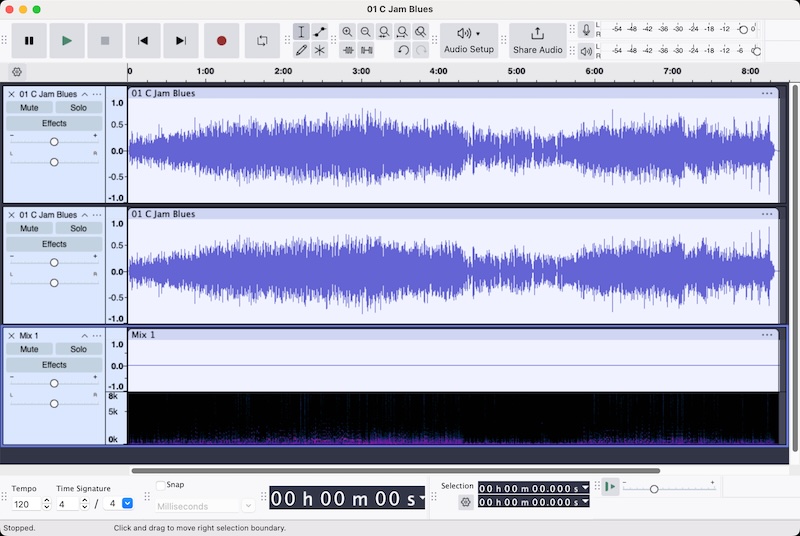
C Jam Blues / Red Garland Trio
from “Groovy” (Prestige / Victor Musical Industires VDJ-1532, 1986)
続いて、1999年の 20bit K2 Super Coding リマスター (Prestige / Victor Entertainment VICJ-60278, 1999) と同一音源の米国盤 (Prestige PRCD-7113-2, 1999) ですが、左右チャンネルの差分がさらに増えているのが確認できます。
Next, here’s the 1999 U.S. CD (Prestige PRCD-7113-2, 1999), presumably from the same source as the 1999 20-bit K2 Super Coding remaster CD (Prestige / Victor Entertainment VICJ-60278, 1999). The difference between the left/right channels has been further increased.
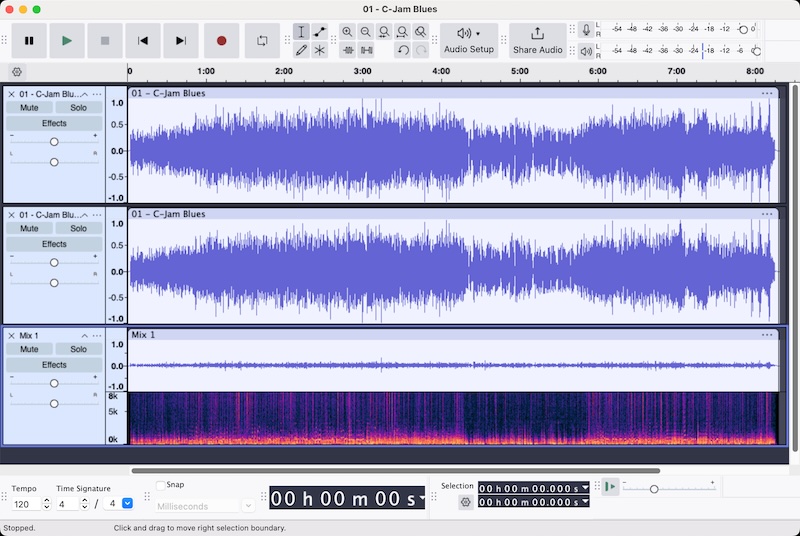
C Jam Blues / Red Garland Trio
from “Groovy” (Prestige PRCD-7113-2, 1999)
さらにその後、2008年の RVG Remasters では、左右チャンネルの差分がますます増加しているのが興味深いです。これまた、なんとなく理由は想像がつきますよね(後述)。
Even later in the 2008 RVG Remasters, it is interesting to note that the difference between the left/right channels is increasing more. Yet again, you can roughly guess why it is happening (will be discussed later).
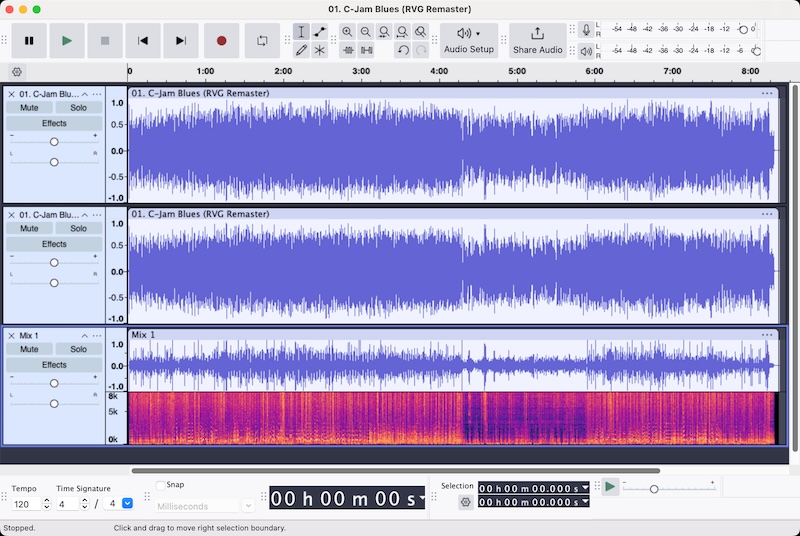
C Jam Blues / Red Garland Trio
from “Groovy” (24/44.1 Hi-Res downloads, master equivalent to Prestige PRCD-30652, RVG Remasters, 2008)
Some other examples / その他いろいろ
Beach Boys の大傑作「Pet Sounds」の CD リイシューでも、やはり同様の違いが見られました。
CD reissues of the Beach Boys’ timeless masterpiece “Pet Sounds” also showed similar differences from release to release.
私が人生で初めて購入した CD でもある、1988年12月リリースの Capitol / Toshiba EMI CP28-1003 では、左右チャンネルがバイナリ一致していました。一方、50th Anniversary Edition (Capitol B0024731-00, 2016) のモノーラルバージョンでは、左右チャンネルの差分が存在していました。
Capitol / Toshiba EMI CP28-1003, released in 1988 (which was also the very first CD I purchased in my life), had binary identical left/right channels. On the other hand, the monaural version on the 50th Anniversary Edition (Capitol B0024731-00, 2016) had some difference between the left/right channels.
こちらは Pet Sounds 50th Anniversary Edition のバージョン (B0024731-00, 2016)
— Kohji Matsubayashi (@kohji405mi16) August 26, 2024
やっぱり差分が微妙にあり https://t.co/oxcDJ7i7yq pic.twitter.com/yszmm2fCBC
夕ラ㋾ さんによると、40th Anniversary Edition (Capitol 09463-73019-2-0, 2006) では、トラックごとに左右チャンネルの差分がバラバラだったりしたそうです。
Also, according to 夕ラ㋾-san, the degree of the left/right diffs on the 40th Anniversary Edition (Capitol 09463-73019-2-0, 2006) varies from track to track.
おはようございます。PetSounds40thのmonoTrackを見てみたら結構差分が出たんですが、なぜか01 Wouldn't It Be Nice と14 Hang On To Your Ego の2曲だけ極端に差分の小さいものでした(ノーマライズかけるとチリチリ言います)。 pic.twitter.com/uLciubklXC
— 夕ラ㋾ (@taraw_o) August 27, 2024
同じく Beach Boys の、初の全米1位となった大ヒットシングル「I Get Around」も、CD リリースごとにバラバラでした。
Similarly, the Beach Boy’s hit single “I Get Around”, which became their first U.S. No. 1 hit, also varies from CD release to CD.
同様に、一番下のトラックが左右チャンネルの差分
— Kohji Matsubayashi (@kohji405mi16) August 26, 2024
I Get Around (mono) / The Beach Boys
1) 2001年 "Little Deuce Coupe & All Summer Long" 2in1 HDCD より
2) 2008年 U.S. Singles Collection より
3) 2012年 “All Summer Long” Mono/Stereo CD より
4) 2013年 "Made in California"… pic.twitter.com/9MTpFrLhQA
Rolling Stones の 1st UK アルバムの CD やディジタル音源でも、同様の違いがみられたりしました。
Similar differences among CD releases (and digital releases) are also found on the Rolling Stones‘ first U.K. album.
ふと思い出したので
— Kohji Matsubayashi (@kohji405mi16) August 26, 2024
Route 66 / Rolling Stones
一番下のトラックが左右チャンネルの差分
左)UK 1st アルバムの 24-88 音源、左右チャンネルの差分あり
右)Stones in Mono 24-192 音源、左右チャンネルは完全一致 pic.twitter.com/Y9mpUOmSsm
Beatles の 1st アルバム「Please Please Me」の初回 CD (Parlophone CDP 7 46435 2, 1987) はモノーラルバージョンですが、やはり全トラックにおいて左右チャンネルの差分が確認できました。
The Beatles’ first CD release of “Please Please Me” album (Parlophone CDP 7 46435 2, 1987) is a monaural version, but again, differences between the left/right channels can be confirmed on all tracks.
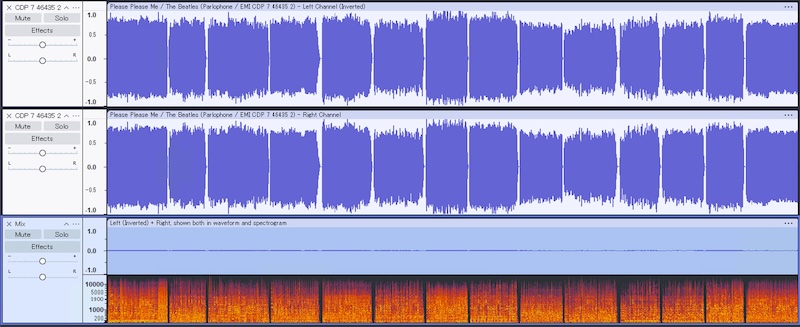
Please Please Me / The Beatles (Parlophone CDP 7 46435 2, 1987).
一方、「The Beatles In Mono」の PPM (Apple / EMI Music Japan TOCP-71041) では、左右チャンネルは完全に一致していました(曲間の無音部を除く)。
On the other hand, on the PPM CD (Apple / EMI Music Japan TOCP-71041) included in “The Beatles in Mono” box set, the left/right channels were perfectly identical (except for the silence between tracks).

Please Please Me / The Beatles
from “Beatles in Mono” Box Set (Apple / EMI Music Japan TOCP-71041〜53)
Bob Dylan の「Highway 61 Revisited」のモノーラルバージョンを収録したハイブリッド SACD (Columbia / Mobile Fidelity Sound Labs UDSACD 2182, 2017) の CD レイヤーでは、やはり左右チャンネルの差分が確認できました。
The CD layer of the hybrid SACD (Columbia / Mobile Fidelity Sound Labs UDSACD 2182, 2017), which contains a monaural version of Bob Dylan’s “Highway 61 Revisited”, shows differences between the left/right channels.
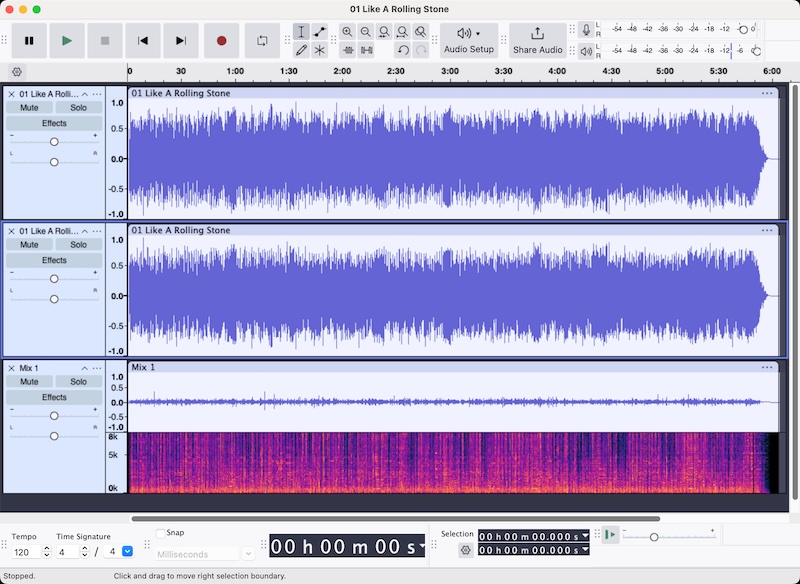
Like A Rolling Stone / Bob Dylan
from the CD layer of the Hybrid SACD “Highway 61 Revisited” (Columbia / Mobile Fidelity Sound Lab UDSACD 2182, 2017)
Robert Johnson の 1936年11月27日 San Antonio, Texas 録音「Crossroad Blues (take 2)」も、過去にさまざまな CD でリイシューされてきました。ミントコンディションのヴァイナルテストプレス盤が新発見される前に出た1990年盤2CDのみ、左右チャンネルの差分がありますが、それ以降のリリースでは差分がありませんでした。
The legendary “Crossroad Blues (take 2)” by Robert Johnson, recorded on November 27, 1936 in San Antonio, Texas, had been reissued on various CD releases. Only the 1990 2CD box set (released years before the newly-discovered mint-condition vinyl test pressings) had differences between the left/right channels, while on all the later releases, the left/right channels are perfectly matched.
Crossroad Blues (take 2) / Robert Johnson CD音源の比較
— Kohji Matsubayashi (@kohji405mi16) September 4, 2024
(1) The Complete Recordings (1990, Columbia C2K 46222), CD1 Track 18
グラミー賞を受賞し当時大変話題になったCDボックス
あの Frank Abbey 氏のマスタリング、左右チャンネル差分あり
テストプレスヴァイナル盤が発掘される前 pic.twitter.com/TltiI3cX5w
(2) King of the Delta Blues Singers (1994, Columbia 484419 2), Track 1
— Kohji Matsubayashi (@kohji405mi16) September 4, 2024
Kevin Boutote マスタリング
ライナーには「新発見のミントコンディションテストプレスからマスタリング」とあるが、音の感触は1990年版に近い pic.twitter.com/k0aFDsmjqS
(3) The Complete Recordings (1996, Columbia 484414 2) CD1 Track 18
— Kohji Matsubayashi (@kohji405mi16) September 4, 2024
1996年 David Mitson 新マスタリング
音の感触が生々しい方向に変化、これは SBM (Super Bit Mapping) の結果の可能性も
テストプレスからの再マスタリングなのかはライナーに記載なしだが、おそらくそうと思われ pic.twitter.com/3FezgvXEqP
(4) Centennial Collection (2011, Columbia Columbia 88697 85907 2) CD1 Track 22
— Kohji Matsubayashi (@kohji405mi16) September 4, 2024
2011年 Seth Winner & Steven Lasker マスタリング
レストアに CEDAR Cambridge 使用
原盤提供者一覧もライナーに表記
テストプレスからの復刻、丁寧なマスタリング、決定版と言える音質 pic.twitter.com/qB97IHrP81
(5) American Epic (2017, Columbia 88875099692) CD5 Track 1
— Kohji Matsubayashi (@kohji405mi16) September 4, 2024
Nicholas Bergh トランスファー、P. Henderson / D. Erikson / J. Tefteller / N. Bergh リマスタリング
テストプレスからの復刻
この5CDに収録された様々なジャンルからの全曲が、丁寧な職人技と愛の賜物、復刻のお手本 pic.twitter.com/7FcjQLQMx0
What could have caused these differences? / 考えられる理由
きりがないのでこの辺でやめますが、モノーラルとされている CD 収録音源の左右チャンネルの差分が、リリースによってこれほどまでの差が生じている理由として、何が考えられるでしょうか。
I will stop here because there’s no end to it, but what could be the reason why the difference between the left/right channels of mono CDs varies so much from release to release?
取り込まれたディジタルデータが1チャンネル分のみで、オーディオCDのマスタを制作する際に左右チャンネルにディジタルコピーすれば、左右チャンネルの差分は当然なくなるはずです。つまり、左右チャンネルを「ディジタル段で」同一データのコピーとする作業が必要となります。
If the digital data transferred from the original master tape was only for one channel, and if it was then digitally copied to the other channel when creating the audio CD master, the difference between the left/right channels should naturally be eliminated. In other words, it would be necessary to copy the same data for the left/right channels “at the digital stage”.
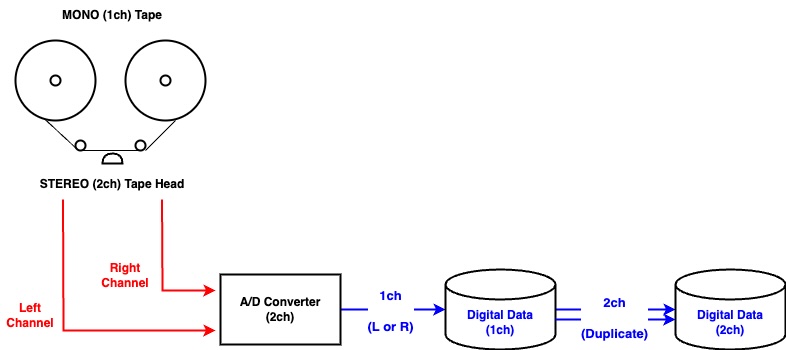
ということは、左右チャンネルの差分があるモノーラル音源というのは、「アナログ段」での差が現れている、と考えるのが自然でしょう。
Therefore, it would be very natural to assume that a monaural CD with a difference between the left/right channels is the result of a difference “in the analogue stage”.
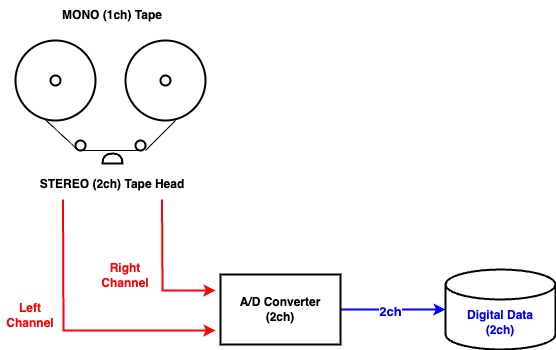
例えば、上で紹介した Buddy Holly の場合はどうでしょうか。
For example, what about the Buddy Holly‘s case presented above?
コンピレーションアルバム「From The Original Master Tapes」は1985年リリース、アルバムを通じてモノーラルの楽曲とステレオの楽曲が収録されており、また LP と CD が同時リリースでした。
The compilation album “From The Original Master Tapes” was released in 1985, and included both mono and stereo tracks. Also, the album was also released simultaneously on LP and CD.
LP 用のカッティングマスターテープ(アナログ)は、当然 2チャンネルステレオテープだったと考えられます。つまり、モノーラルの楽曲は、そのステレオテープの左右チャンネルに(ほぼ)同内容が記録されていたことになります。
The cutting master tape (analog) for LPs would naturally be a 2-channel stereo tape. This means that the monaural tracks were recorded (almost) identically on the left/right channels of the stereo tape.
このテープをもとに、2チャンネルステレオの A/D コンバータを使ってディジタルマスターを作るわけですから、結果として記録される左右チャンネルのディジタルデータが微妙に異なるのは当然、ということになりますね。
Since a digital master (for CD) can be assumed to be created from this tape using a 2-channel stereo A/D converter, the resulting digital data of the left/right channels would naturally be different slightly.
また、モノーラルのオリジナルマスターテープをテープデッキで再生する際、ステレオ (2ch) 用のヘッドを使っていたことも考えられます。歴史的名録音をオリジナルマスターテープから高品質リマスタリングするのがブームになっている昨今ならともかく、1985年の段階で「わざわざ」ヴィンテージのモノーラル (1ch) ヘッド付テープデッキを調達するとは思えないからです。
It would also be possible that the original monaural master tapes were played back on a tape deck with stereo (2-chnanel) heads. It would likely be that few engineers at the time “bothered” to procure a vintage monaural (1-channel) tape deck with a monaural head, although it might be possible in these days of boom in high-quality remastering of historical master tapes.
一方、2004年リリースの Erick Labson リマスター CD、2017年リリースの Cohearent Audio でのリマスター CD の場合は、A/D コンバータでディジタルトランスファーされたデータを使い、1チャンネルの同一データを意図的に左右チャンネルに割り当てることで、左右チャンネルがバイナリ一致した CD / SACD が制作されたのでしょう。
On the other hand, in the case of the Erick Labson remastered CD (2004) and the Cohearent Audio remastered CD (2017), the same monaural data from one channel was intentionally assigned to the left and right channels, using data digitally transferred by an A/D converter. By assigning the same digital data to the left/right channels, a CD/SACD with binary-matched left/right channels would have been produced.
The Stairs の 1992年リリースのアルバムは、Liverpool の Avid Studios で Steve Powell によって録音されました。
The Stairs‘ 1992 album was recorded by Steve Powell at Avid Studios in Liverpool.
そもそもこのアルバムが、1960年代(ガレージ)ロックへのひねくれオマージュ的なこだわり満載だったわけですし、録音がアナログテープに行われていたとしても不思議ではありませんよね(未確認)。
The album was full of twisted homage to 1960s (Garage) Rock, and it would not be surprising if the recording was done on analog tape (uncomfirmed).
もしそうであるならば、CD マスターはそのアナログテープからストレートに 2チャンネルの A/D コンバータを介して制作され、結果として左右チャンネルの差分が多少発生していたのかも、と考えられます。
If it was so, the CD master was produced straight from the analog tape via a two-channel A/D converter, which may have resulted in some difference between the left/right channels.
Beach Boys の「Little Saint Nick」モノーラルシングルバージョンについては、1989年日本盤CDでは、東芝EMIの担当エンジニアが、モノーラル音源についてはディジタル段で左右チャンネルを意図的に同一データにしていたのでしょう。こういう潔癖症的こだわりは、もしかしたら日本の方が強い傾向があるのかもしれませんね(確証はなし)。
As for the monaural single version of the Beach Boys‘ “Little Saint Nick”, the engineer in charge of the 1989 Japan CD at Toshiba EMI must have intentionally made the left and right channels the same data in the digital stage for the monaural source. This kind of fastidiousness may be stronger in Japan (no proof — it’s just my guess).
元がアナログテープだった場合は、2チャンネルの A/D コンバータでディジタルに取り込み、そのうち望ましい片チャンネルを採用し、もう片チャンネルにデータとして複製したのかもしれません。
If it was an analogue tape sent from the U.S., it might have been captured digitally by a two-channel A/D converter, one desirable channel of which would have been adopted and duplicated as data on the other channel.
元がディジタルテープだった場合でも、左右チャンネルのディジタルデータを比較し、望ましい方を採用、もう片チャンネルに複製したと考えられます。
Even in the case of digital tapes sent from the U.S., the digital data of the left and right channels were compared, the preferred one was adopted, then it was duplicated to the other channel.
で、1991年米国盤CDの方では、モノーラルシングルバージョンのマスターテープをステレオヘッドで再生し、2チャンネルの A/D コンバータを介してディジタルトランスファーした「2チャンネルの」データをそのまま使ったため、左右チャンネルの差分が発生していたのでしょう。
As for the 1989 U.S. CD reissue, the master tape of the monaural single version was played with a stereo tape head and the “2-channel” data digitally transferred through a 2-channel A/D converter was used as is, which probably caused the difference between the left/right channels.
Red Garland の「Groovy」の場合、2008年版は Rudy Van Gelder ご本人によるディジタルリマスターです。当時の LP の時代には、オリジナルセッションマスターテープに様々なイコライズなどの処理を過激に(?)加えてカッティングマスターを制作していました(拙稿「Things I Learned on Phono EQ Curves」の Pt. 24 セクション 24.2 参照)。ですから、このディジタルリマスターの際にも、1950年代〜1960年代の音を再現するために、アナログ段でさまざまな処理を施しつつ、それを最終的にA/Dコンバータで「2チャンネル分の」データとして取り込んだ可能性が考えられます。
In the case of Red Garland‘s “Groovy”, the 2008 version was digitally remastered by Rudy Van Gelder himself. In those days of LPs, cutting masters were produced by RVG by adding various equalizations and other extreme (?) processing to the original session tapes (see also: Pt. 24 Section 24.2 of my blog article series “Things I Learned on Phono EQ Curves”). Therefore, it is possible that RVG’s digital remastereing was done by applying various processes in the analog stage in order to reproduce the sound of the 1950s-1960s, and finally imported as “2-channel” digital data by A/D converters.
一方、1999年の 20bit K2 Super Coding 盤は、マスターテープをステレオヘッドで再生し、2チャンネルのA/Dコンバータを介してディジタルトランスファーした「2チャンネルの」データをそのまま使い、左右チャンネルの差分が発生していると考えられます。
On the other hand, the 1999 20bit K2 Super Coding CD would use the “2-channel” digital data as it is, played back on the master tape with a stereo head and digitally transferred through an A/D converter, which might cause the difference between the left/right channels.
そして、ビクター音産の1986年版 (VDJ-1532)において、左右チャンネルの差分がゼロではなく、ほんのわずかだけみられるのは、1チャンネル(モノーラル)のアナログデータを分岐して、2チャンネルの A/D コンバータでディジタルトランスファーしたため、なのかもしれませんね。
And the fact that the difference between the left/right channels in the 1986 Victor Musical Industries version (VDJ-1532) is not zero, but only a little. This might be due to the fact that the analog data of one channel (monaural) was split and digitally transferred by two-channel A/D converters (for left/right channels).
Tentative Conclusion (so far) / 暫定的結論
元がモノーラル録音である音源の CD 化の場合であっても、CD が 2チャンネルの規格であるため、両チャンネルに意図的に同一ディジタルデータを割り当てない限り、アナログ段の微妙な差が CD マスターにも記録されることとなり、結果として左右チャンネルのデータが微妙に異なる CD となる、そのように考えられます。
Since CD is a 2-channel format, when a sound source that is originally a monaural recording is converted to CD, subtle differences in the analog stage will be recorded in the CD master as well, resulting in a CD with slightly different digital data for the left and right channels. This always happens, unless the same digital data is intentionally assigned to both channels.
とはいえ、左右チャンネルに微妙な差分があったとしても、ステレオ装置で再生する際、我々は(ごく一部の例外的なリリースを除いて)何の違和感もなく聴いてきたわけですよね。
Nevertheless, even if there is a subtle difference between left/right channels, we have been listening to such “monaural” CDs (and digital releases) without any discomfort when playing them on stereo equipment (with the exception of a few releases).
1950年代〜1960年代音源のリイシューに従事してきた米国の某マスタリングエンジニアに話を伺ってみたところ、話は単純ではなさそうです。いわく、70年近く前の1トラックモノーラルマスターテープの状態、2トラックテープヘッドでの読み取りによるアジマスずれ(iZOTOPE RX などである程度は自動修正できる場合もあるが完璧ではない)、片チャンネルだけ使うことによるヒスノイズと S/N 比の問題、などが絡まり、トランスファーした2トラックモノをそのまま使うのが好ましい場合も多いとのことです。
I contacted a certain mastering engineer in the U.S. who has been engaged in reissuing 1950s-1960s sound recordings, and he kindly gave me replies. According to him, there are a number of factors involved: the condition of 1-track monaural master tapes from nearly 70 years ago; azimuth misalignment caused by reading with a 2-track tape head (which can be corrected automatically to some extent with iZOTOPE RX and/or other products, but not perfectly); tape hiss noise and signal to noise ratio caused by using only one channel, etc., and in many cases, it is preferable (for him) to use the transfered two-track mono as it is.
どうやら、モノーラルの旧アナログ音源をディジタルリマスターする場合、マスターテープの状態や再生機器に依存する側面が多く、結果としてさまざまな技術プラクティスが存在し、画一的な方法というのはなさそう、ということのようです。これが、左右チャンネルの差分が全くないモノーラル CD から、そこそこあるモノーラル CD まで、時代によらず、さまざまなバリエーションが存在している理由なのでしょう。
Apparently, when digitally remastering old analog monaural recordings, there are many aspects that depend on the condition of the master tapes and the playback equipment, and as a result, there are many different engineering practices, and it seems that there is no uniform method. This is probably the reason why there are so many variations of mono CDs, ranging from CDs with no difference between channels to CDs with some difference, regardless of the era.
現在では、世界中において、音楽再生環境は最低でも2チャンネルステレオ(あるいはそれ以上のマルチチャンネル)と考えて差し支えありません。そのため、本来ならばスピーカ1本で聴くのが正しかったモノーラル音源は、最低2本のスピーカで再生されることがほとんどでしょう。
Today, almost all music playback equipment around the world can be considered to be at least 2-channel stereo (or even more multichannel). Therefore, a monaural sound source that would normally be played through a single loudspeaker will most likely be played through at least two loudspeakers these days.
そして、普通にモノーラル CD やディジタル音源をステレオ装置で再生して楽しむにあたり、左右チャンネルが完璧に同一データかどうか、単純に聴いている限りはあまり気になりませんし、再生音質に大きな影響があるのか否かも正直分かりません。おそらく、大して関係ないんだろうんなぁ、と思っています(笑)
Also, when reproducing “monaural” CDs (or digital files) with stereo equipment, we do not really care whether or not the left/right channels are perfectly (binary) identical, as long as we are simply listening to the music. I honestly don’t know if it has a significant impact on the sound quality of playback or not — I guess maybe it doesn’t 🙂
ですから、聴く際に違和感を感じない限りにおいては、厳密に左右チャンネルがディジタルデータとして完全に同一であることにこだわる必要はないのかもしれませんね。
Therefore, as long as you do not feel any discomfort when listening, it may not be necessary to insist that the left/right channels are exactly the same in terms of digital data.
ただ、コンピュータやソフトウェアエンジニアリングの世界、すなわち、ディジタルの世界に長らく身を置いてきた自分としては、「モノーラル音源と謳っているのに、どうして左右チャンネルのデータがバイナリ一致していないのかなぁ?」と「気持ち悪さ」を感じるのも事実です(笑)
On the other hand, as someone who has spent a long time in the world of computers and software engineering (i.e. the “digital” world), it is true that I feel somewhat “weird” when I wonder why the data of the left/right channels are not binary-matched, even though it is claimed to be a monaural sound source 🙂
もし、どうしても気になるのであれば、左右いずれかのチャンネルのみを抽出して、それをコピーすることで、完璧にデータ一致する「2チャンネル」「モノーラル」音源を作ることができますね。
If you were really concerened, you would be able to create a “2-channel mono” data by extracting only one of the left/right channels and copying it to the other.
また、オーディオ CD (CD-DA) からリッピングしたディジタルデータファイルとなった時点で、チャンネル数は2チャンネルである必要はありませんから、1チャンネルのみのモノーラルファイルにして、それを普通に DAC で再生すれば、同一データが左右チャンネルに送り込まれるわけですよね。
Also, when a digital data file is ripped from an audio CD (CD-DA), the number of channels does not have to be two, so if you make a monaural file with only one channel and play it on a DAC as usual, the same data will be sent to the both channels of the reproducing equipment.
CDのまま聴きたい、あるいは、リッピングしたデータに手を加えたくない、という場合は、(ひと昔前のステレオプリアンプによく装備されていた)「モード」スイッチを使用して、「左チャンネルのみを両チャンネルで再生」「右チャンネルのみを両チャンネルで再生」なんてこともできますね。
If you want to listen to the CD as-is, or if you don’t want to modify the ripped data, you may use the “mode” switch (which was often equipped in old stereophonic amplifiers) to select “play the left/right channel only on both speakers”.
ま、いずれにせよ、今回の「モノ音源のCDの左右チャンネル差分問題」は、「気分の問題」といっていいかもですから、気にしない方がいいですよね。。。けどやっぱり気になってしまう、という。。。(笑)
Well, anyway, the “difference between left/right channels of mono CDs” may be a “matter of feelings”, so it is better not to worry about it… However, it still bothers me sometimes… 🙂
(Postscript / 追記)
2007年の時点で、同様の議論が Steve Hoffman Music Forum で行われていたことに気づきました(笑)ので、リンクを置いておきます。
I noticed a similar discussion on the Steve Hoffman Music Forum back in 2007, so I’m putting a link to it here.


